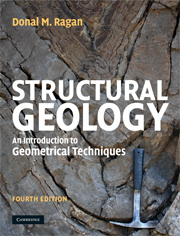Book contents
- Frontmatter
- Contents
- Preface
- Acknowledgements
- 1 Structural planes
- 2 Thickness and depth
- 3 Lines and intersecting planes
- 4 Planes and topography
- 5 Stereographic projection
- 6 Rotations
- 7 Vectors
- 8 Faults
- 9 Stress
- 10 Faulting
- 11 Deformation
- 12 Strain
- 13 Flow
- 14 Folds
- 15 Parallel folds
- 16 Similar folds
- 17 Folds and topography
- 18 Structural analysis
- 19 Tectonites
- 20 Drill hole data
- 21 Maps and cross sections
- 22 Block diagrams
- Appendices
- References
- Index
13 - Flow
Published online by Cambridge University Press: 05 June 2012
- Frontmatter
- Contents
- Preface
- Acknowledgements
- 1 Structural planes
- 2 Thickness and depth
- 3 Lines and intersecting planes
- 4 Planes and topography
- 5 Stereographic projection
- 6 Rotations
- 7 Vectors
- 8 Faults
- 9 Stress
- 10 Faulting
- 11 Deformation
- 12 Strain
- 13 Flow
- 14 Folds
- 15 Parallel folds
- 16 Similar folds
- 17 Folds and topography
- 18 Structural analysis
- 19 Tectonites
- 20 Drill hole data
- 21 Maps and cross sections
- 22 Block diagrams
- Appendices
- References
- Index
Summary
Introduction
As we have seen in Chapter 11, the study of deformation is concerned solely with a comparison of a body of rock in its initial and final configurations: the translation compares the initial and final places, the rotation compares the initial and final orientations, and the stretch compares the initial and final shapes and sizes (see Fig. 11.2). No consideration is given to intermediate configurations or to a particular sequence of configurations (Mase, 1970, p. 77).
However, the motion or flow by which a particular deformed state is attained is also of considerable interest if we are to understand the processes involved in the formation of geological structures. Kinematics is the branch of mechanics concerned with the motion of bodies without regard to any associated forces.
In this chapter we first treat the basic elements of a kinematic analysis by describing the measured velocity field in a tectonically active area and the information that can be derived from it. Second, we consider an approach to the more difficult problem of understanding the flow responsible for old structures. Third, by considering the progressive geometrical evolution of structures we can gain some insight into the geometrical nature of geological flow patterns. Finally, after treating some important theoretical matters, we use these results to consider briefly an alternative approach to estimating the time rates of deformation.
- Type
- Chapter
- Information
- Structural GeologyAn Introduction to Geometrical Techniques, pp. 346 - 368Publisher: Cambridge University PressPrint publication year: 2009

